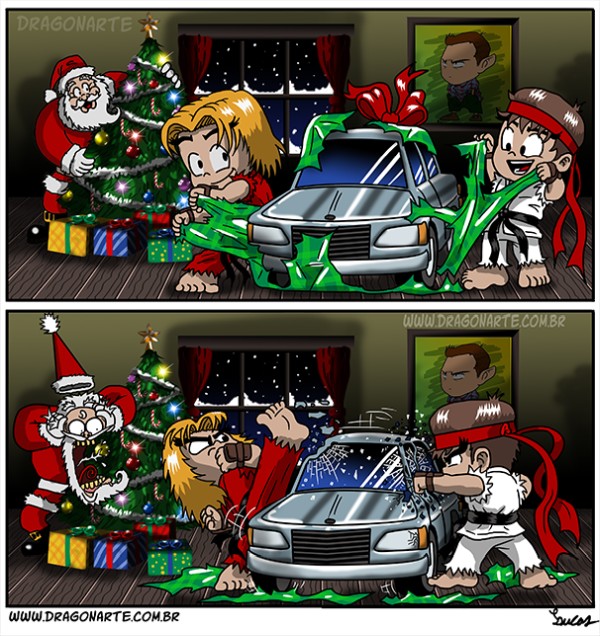For today’s edition of Deal of the Day, Amazon has THOUSANDS of blu-ray and 4K titles for under $10 each, with many priced considerably lower than that! Check them all out at the link, or select the category you are interested in via the left section on the sale page! There are a lot of great titles in there! Please note that Geeks are Sexy might get a small commission from qualifying purchases done through our posts (As an Amazon associate or a member of other affiliate programs. As an Amazon Associate, I earn from qualifying purchases.)
The Abominable Snowman [Comic]
[Source: @gogomachrocketsheep]
Ken, Ryu, and Santa [Comic]
Innovation [Comic]
A Christmas Song About the Inevitable Robot Apocalypse [Video]
01010111 01101000 01100101 01101110 00100000 00100010 01010010 01101111 01100011 01101011 01101001 01101110 00100111 00100000 01000001 01110010 01101111 01110101 01101110 01100100 00100000 01010100 01101000 01100101 00100000 01000011 01101000 01110010 01101001 01110011 01110100 01101101 01100001 01110011 00100000 01010100 01110010 01100101 01100101 00100010 00100000 01101101 01100101 01100101 01110100 01110011 00100000 01110100 01101000 01100101 00100000 01110010 01101111 01100010 01101111 01110100 00100000 01100001 01110000 01101111 01100011 01100001 01101100 01111001 01110000 01110011 01100101 00101100 00100000 01110100 01101000 01101001 01110011 00100000 01101001 01110011 00100000 01110111 01101000 01100001 01110100 00100000 01111001 01101111 01110101 00100000 01100111 01100101 01110100 00101110 00100000 01000001 00100000 01100110 01100001 01101110 01110100 01100001 01110011 01110100 01101001 01100011 00100000 01100011 01101111 01110110 01100101 01110010 00100000 01100010 01111001 00100000 01011001 01101111 01110101 01110100 01110101 01100010 01100101 01110010 00100000 01110011 01100001 01101101 01110101 01110010 01100001 01101001 01100111 01110101 01101001 01110100 01100001 01110010 01101001 01110011 01110100 00101110
CRAZY INSANE DEALS on Holy Stone HS720G GPS Pro 4K FPV Drone, Baseus 65W 20000mAh Power Bank, DJI Power 1000 1024Wh Portable Power Station, 1TB Cloud Storage (Lifetime), and MORE!
For today’s edition of “Deal of the Day,” here are some of the best deals we stumbled on while browsing the web this morning! Please note that Geeks are Sexy might get a small commission from qualifying purchases done through our posts. As an Amazon Associate, I earn from qualifying purchases.
–Holy Stone HS720G GPS Pro FPV Drone with 4K Camera, FAA, 2-Axis Gimbal, Built-in Remote ID, 120°FOV, Brushless Motor, 5G WiFi Transmission, Smart Return Home – $299.99 $86.15 (Clip Coupon at the Link and Use Promo Code 2835ENPQ at Checkout)
–Baseus 65W 20000mAh Power Bank – $49.99 $19.99 (Clip Coupon at the Link + Use Promo Code 4QP4KMSC at Checkout)
–Soundcore Boom 2 Speaker By Anker, 80W, Subwoofer, BassUp 2.0, 24H Playtime, IPX7 Waterproof, Floatable, RGB Lights – $129.99 $89.99
–DJI Power 1000 Portable Power Station, 1024Wh LiFePO4 Battery, 2200W (Peak 2600W) – $899.00 $469.00
–Eveready LED Camping Lantern 360 PRO (3-Pack), Super Bright Tent Lights, Rugged Water Resistant LED Lanterns, 100 Hour Run-time (Batteries Included) – $29.99 $17.79
–100 Paper Spaceships to fold and fly – $8.99 $6.74
–Koofr Cloud Storage: Lifetime Subscription (1TB) – $810.00 $109.97
–1minAI: Lifetime Subscription – Why choose between ChatGPT, Midjourney, GoogleAI, and MetaAI when you could get them all in one tool? – $234.00 $39.99
–Costco 1-Year Gold Star Membership + FREE $45 Digital Costco Shop Card – $65.00
Time well spent [Comic]
[Source: @adhdinos]
I Love Cuttlethulu [Comic]
[Source: @kelsiebru]
Elf on the Shelf: Black Ops [Comic]
[Source: @glass.housescomics]
The Sword of Truth [Comic]
[Source: @swordscomic]









